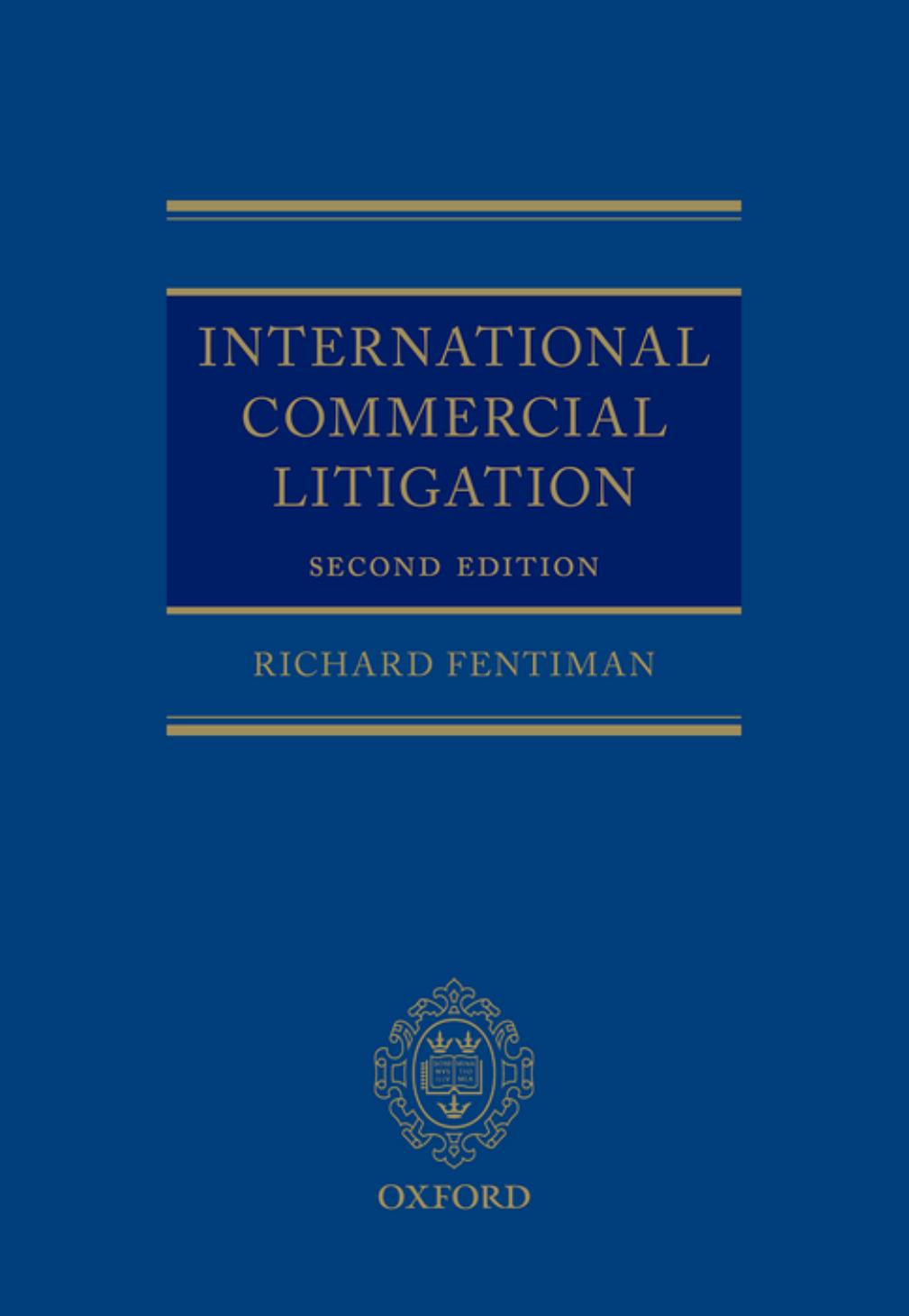International Commercial Litigation 2nd edition by Richard Fentiman ISBN Print ISBN 9780191022005 0191022004
$70.00 Original price was: $70.00.$35.00Current price is: $35.00.
Instant download International Commercial Litigation after payment
International Commercial Litigation 2nd edition by Richard Fentiman – Ebook PDF Instant Download/Delivery: 9780191022005, 0191022004
Full dowload International Commercial Litigation 2nd edition after payment

Product details:
ISBN 10: 0191022004
ISBN 13: 9780191022005
Author: Richard Fentiman
International Commercial Litigation
International Commercial Litigation 2nd Table of contents:
I Introduction
1. Introduction
I. Legal Risk and Commercial Disputes
II. The Anatomy of Risk
A. Species of legal risk
B. Risk, opportunity, and uncertainty
III. Concepts and Context
A. The practical context
B. The dynamics of multistate litigation
C. Objectives of legal regulation
D. Objectives of English law
E. Principles of English law
F. Tensions in English law
G. Legal risk in English law
H. The conceptual structure of the EU regime
I. English law and EU law
IV. Costs in International Commercial Litigation
V. Future Developments
VI. The Enquiry
A. Scope
B. Assumptions
C. Structure
II Legal Risk and Multistate Litigation
2. Managing Litigation Risk
I. Litigation Risk
II. Dispute-resolution Clauses
A. The anatomy of dispute-resolution clauses
B. Commercial dispute-resolution clauses
III. The Legal Role of Jurisdiction Agreements
A. Five regimes
B. The Hague Convention
C. Agreements designating EU courts
D. Agreements designating non-EU courts
IV. The Interpretation of Jurisdiction Agreements
A. The applicable law
B. Principles of interpretation
C. The scope of jurisdiction agreements
D. The effect of the agreement
V. Enforceable Jurisdiction Agreements
A. Agreements designating EU courts: Brussels I bis
B. Agreements designating EU courts: Brussels I
C. Agreements designating non-EU courts
D. The incorporation of jurisdiction agreements
VI. Enforceability and Asymmetric Agreements
A. Summary
B. Context
C. Effectiveness and Article 25
D. Asymmetric agreements beyond Brussels I bis
E. Hybrid jurisdiction/arbitration clauses
VII. Enforceability Against Third Parties
A. Litigation risk and privity
B. Third parties as constructive parties
C. A non-contractual solution: independent consent
D. Unanswered questions
VIII. The Risk of Pre-emptive Proceedings
A. Nature of the risk
B. Pre-emptive proceedings in a non-EU state
C. Pre-emptive proceedings in an EU state
IX. Discretionary Non-enforcement
A. Discretion and risk
B. Legal framework
C. Discretion and the Hague Convention
D. Discretion in English law
X. Collateral Enforcement
A. Damages against a pre-emptive claimant
B. Damages against a claimant’s advisers
C. Indemnity clauses
D. Waiver clauses
3. Managing Transaction Risk
I. The Anatomy of Transaction Risk
A. Ineffective transactions
B. Ineffective governing law clauses
II. The European Regime
III. Negotiation Risk
IV. Formation Risk
V. Counterparty Risk
A. Introduction
B. Counterparty risks
VI. Initial Performance Risk
A. Two risks
B. Types of initial risk
C. Compliance with the mandatory laws of the forum
D. Compliance with the public policy of the forum
E. Compliance with the law of the place of performance
F. Compliance with the most connected law
G. Compliance with the proprietary law
VII. Supervening Performance Risk
A. Nature of the risk
B. Limits to supervening performance risk
C. Legal change in the contractual law
D. Legal change to a counterparty’s status
E. Legal change in the place of performance
F. Forced transfer of rights and obligations
VIII. Performance Risk and Pre-Regulation Contracts
IX. Recharacterization Risk
A. Adverse recharacterization
B. Characterizing an issue
C. Characterizing a transaction
III Liability and Recovery in Multistate Litigation
4. The Dynamics of Choice of Law
I. Risk, Practice, and the Conflicts Process
II. The Conflicts Process
III. Mandatory Application of the Forum’s Law
A. The local law of the forum
B. The province of local law: procedure
C. Overriding local rules
D. Overriding local norms: public policy
IV. Voluntary Reliance on Foreign Law
V. Allocation to a Choice-of-Law Regime: Characterization
VI. The Concept of the Applicable Law: Renvoi
A. Renvoi in practice
B. Renvoi in principle
5. The Laws Governing Multistate Transactions
I. Introduction
A. Transactions in litigation
B. The European regime
II. The Law Governing Contractual Issues
A. Generic and specific contracts
B. The scope of the contractual law
C. Transaction risk
D. Defining the contractual law
E. Identifying the contractual law
F. Express choice of the contractual law
G. Implied choice of the contractual law
H. Procedural choice of the contractual law
I. The contractual law in the absence of choice
J. The law governing related contracts
K. The law governing pre-Regulation contracts
III. The Law Governing Transfers of Title
A. Connecting factors
B. Title to tangible movables
IV. The Law Governing the Assignment of Debts
A. The risk of ineffective assignments
B. The EU regime
C. The Article 14 framework
D. Article 14 and complex transactions
E. Future developments
6. The Laws Governing Recovery
I. Transaction Loss
II. Concurrent Claims
III. Full Value Recovery
A. Costs, currency risk, and interest
B. Costs and net recovery
C. Interest and cross-border claims
D. Judgment in the currency of loss
IV. Contractual Recovery
V. Non-Contractual Recovery: Tort and Culpa in Contrahendo
A. Two regimes
B. The 1995 Act
C. Introduction to Rome II
D. The primary rule: party autonomy
E. The default rules in tort
F. Culpa in Contrahendo
VI. Non-Contractual Recovery: Restitution
VII. Non-Recovery: Exemption Clauses
IV Commencing and Preventing Proceedings
7. Strategic Choices
I. Strategy and Litigation
II. Investment, Settlement, and Litigation
III. The Legitimacy of Forum Shopping
IV. A Claimant’s Choices
A. The decision to claim
B. The choice of cause of action
C. The choice of legal mode
D. The choice of forum
V. A Defendant’s Choices
VI. The Legal Framework of Forum Selection
A. Procedural and substantive issues
B. International civil procedure
C. The substantive law in transnational proceedings
8. The Framework of Jurisdiction
I. Two Regimes
II. The Framework of the European regime
A. The European regime in commercial disputes
B. Principles governing the EU regime
III. The Framework of English National Law
A. Introduction to the English law model
B. Defendants in England and Wales
C. Defendants outside England and Wales
IV. Effecting Service
A. The significance of service
B. Service in England
C. Service abroad
V. Pervasive Problems in Jurisdiction Disputes
A. Four problems
B. Interlocutory findings in jurisdiction disputes
C. Claims related to a contract
D. Jurisdictional challenges and summary judgment
9. Establishing and Challenging Jurisdiction
I. Venue Risk and Corporate Strategy
II. Establishing and Challenging Jurisdiction
A. Two regimes
B. Grounds of jurisdiction
III. Submission to the English Court
A. The European regime
B. English law
IV. Corporate Presence in England
A. Introduction
B. Corporate domicile
C. A place of business
V. Presence of an Agent in England
A. Corporations domiciled in an EU or EFTA state
B. Corporations domiciled in a non-EU, non-EFTA state
%0


